Lamb Rack Recipe: When it comes to a dish that impresses guests yet remains surprisingly simple to make, the lamb rack tops the list. It’s elegant, packed with flavor, and turns an ordinary evening into a special occasion.
In this guide, we’ll walk you through a foolproof lamb rack recipe, giving you every step needed to master this classic dish, whether you’re a beginner or a seasoned cook.
What is a Lamb Rack?
A lamb rack is one of the most prized cuts of lamb. It comes from the rib section and typically includes eight rib chops, connected by a single muscle and beautifully marbled with fat. What makes a rack of lamb so special is not just its tenderness but its impressive presentation. When cooked correctly, it’s juicy, flavorful, and tender, making it a showstopper for any meal.
You might have heard of “frenched” lamb racks, where the bones are cleaned of fat and meat for a neater look. This is the version most often seen in fine dining. A lamb rack can be roasted whole or cut into individual chops after cooking, offering flexibility based on how fancy you want to get.
Essential Ingredients for the Perfect Lamb Rack
To cook an outstanding lamb rack, you don’t need a long list of complicated ingredients. Here’s what you’ll need:
- 1 rack of lamb (8 ribs, about 1.5 to 2 pounds)
- 2 tablespoons olive oil
- 4 cloves garlic, minced
- 1 tablespoon fresh rosemary, chopped
- 1 tablespoon fresh thyme, chopped
- 1 teaspoon kosher salt
- 1/2 teaspoon black pepper
- 1 tablespoon Dijon mustard (optional for crust)
Each ingredient plays a crucial role. Fresh herbs lend a burst of earthy flavor, garlic intensifies the savory notes, and good quality olive oil helps form a luscious crust. Always opt for fresh herbs and top-quality lamb for best results. Trust me, it’s worth it!
Choosing the Right Lamb Rack
Not all lamb racks are created equal. When shopping, keep these tips in mind:
- Color: Look for lamb that’s pale pink with fine grain. Dark red meat can indicate older lamb, which is tougher.
- Fat: A thin layer of white, creamy fat is a good thing. It bastes the meat as it cooks, keeping it moist.
- Bones: Decide if you want a frenched rack for an elegant look or an unfrenched rack for a more rustic presentation.
- Source: Whenever possible, buy from a trusted butcher. Ask if the lamb is grass-fed, as it tends to have better flavor.
Picking the right rack is like laying the foundation for a great dish—you simply can’t skip this part.
Necessary Tools and Equipment
Cooking lamb rack doesn’t require fancy equipment, but having the right tools will make a big difference:
- Sharp chef’s knife
- Cast-iron skillet or oven-safe heavy pan
- Meat thermometer
- Tongs
- Cutting board
The meat thermometer is non-negotiable if you want that perfectly pink center without any guesswork. A sturdy skillet allows you to sear the lamb evenly and transfer it straight into the oven without hassle.
How to Prepare Lamb Rack: Step-by-Step
Preparing a lamb rack might seem intimidating, but once you break it down, it’s super manageable. Here’s how to do it:
- Trim Excess Fat: If your rack isn’t already trimmed (frenched), remove any thick layers of fat. Leave a thin layer to enhance flavor during cooking.
- Score the Fat: Lightly score the fat cap with a sharp knife in a crisscross pattern. This helps the seasonings penetrate deeper and renders the fat more effectively.
- Season Generously: Rub the lamb all over with olive oil, garlic, rosemary, thyme, salt, and pepper. Make sure every inch is coated. If you want an extra flavor punch, slather on a thin layer of Dijon mustard before seasoning.
- Marinate (Optional): For deeper flavor, you can marinate the lamb rack in the fridge for 1-2 hours—or even overnight if time allows. Bring it back to room temperature before cooking.
This step is all about building flavor. Think of it like priming a canvas before painting—you’re setting yourself up for a masterpiece!
Best Seasonings and Marinades for Lamb Rack
Lamb has a naturally rich and slightly gamey flavor, which makes it perfect for bold seasonings. Here are some of the best combinations:
- Classic Herbs: Rosemary, thyme, oregano, and sage work beautifully.
- Garlic and Mustard: A savory mix that enhances the lamb’s natural taste.
- Mediterranean Style: Olive oil, lemon zest, parsley, and a pinch of cumin.
- Spicy Marinade: Smoked paprika, chili flakes, and a splash of balsamic vinegar.
DIY Simple Marinade Recipe:
- 1/4 cup olive oil
- 4 cloves garlic, minced
- 2 tablespoons fresh rosemary
- 1 tablespoon Dijon mustard
- Zest of 1 lemon
- Salt and pepper to taste
Whisk everything together and slather it on the lamb. Let it sit for at least an hour for a mouthwatering flavor boost.
Using the right seasoning is like dressing for a party—you want to make sure your star (the lamb) looks and tastes fabulous!
How to Sear a Lamb Rack Properly
Searing is crucial because it locks in juices and builds a flavorful crust. Here’s how to do it:
- Preheat Your Pan: Get your cast-iron skillet smoking hot. This ensures a good sear right away.
- Place the Rack Fat-Side Down: Press the lamb into the skillet and don’t move it for about 2-3 minutes.
- Sear the Other Sides: Flip the rack to sear the bottom and the sides, using tongs to hold it up if needed.
- Sear Quickly: You’re not cooking the lamb through at this point—just creating a golden-brown crust.
A good sear should smell incredible—rich, nutty, and savory. Think of it as the lamb’s golden armor before it heads into battle (aka the oven).
Oven Roasting: The Perfect Method
Once your lamb rack is beautifully seared, it’s time to finish it off in the oven:
- Preheat Your Oven: Set it to 400°F (200°C).
- Roast Fat-Side Up: This helps the fat drip down and baste the meat naturally.
- Use a Thermometer: Insert a meat thermometer into the thickest part. Here’s a quick guide:
- Rare: 120°F (49°C)
- Medium-Rare: 125°F (52°C)
- Medium: 130°F (54°C)
- Roast Time: Generally, it takes about 15-20 minutes depending on your desired doneness and rack size.
Always trust your thermometer over time estimates. It’s like having a GPS for perfectly cooked lamb—no more guesswork!
Resting the Lamb Rack
After roasting, you might be tempted to slice into your lamb immediately—but hold on! Resting the lamb is crucial to keeping it juicy and flavorful.
When meat cooks, its juices are pushed toward the center. Resting allows those juices to redistribute throughout the meat instead of spilling out when you cut it. Here’s how to do it right:
- Transfer to a Plate: Carefully move the lamb rack to a plate or cutting board.
- Tent Loosely with Foil: Don’t wrap it tightly. Just lay a piece of foil over the top to keep it warm.
- Rest for 10-15 Minutes: This gives the juices time to settle.
Think of it like letting a cake cool after baking—if you rush, you ruin the texture. Let patience reward you with juicy, tender lamb that tastes every bit as incredible as it looks.
Slicing the Lamb Rack Correctly
Now that your lamb has rested, it’s time to slice and serve. Done wrong, you can tear the meat or crush the beautiful seared crust. Here’s how to do it properly:
- Position the Rack Upright: Place the rack so the bones are pointing upward, with the fat side facing you.
- Slice Between the Ribs: Using a sharp knife, cut straight down between each bone to create even chops.
- Keep It Neat: Wipe the knife with a damp cloth between cuts for a cleaner presentation.
Each chop should have a neat little bone handle and a juicy pink center. It’s basically the food equivalent of handing each guest a tiny, delicious masterpiece.
Serving Suggestions
A rack of lamb deserves some stellar sidekicks on the plate. Here are a few ideas:
Perfect Side Dishes:
- Garlic Mashed Potatoes: Creamy, buttery, and a classic pairing.
- Roasted Vegetables: Think carrots, parsnips, and Brussels sprouts.
- Minted Peas: The freshness of mint balances the richness of lamb.
Wine Pairings:
- Cabernet Sauvignon: Full-bodied and bold enough to stand up to the lamb.
- Syrah/Shiraz: A spicy option that plays beautifully with the herbs and garlic.
When serving, arrange the chops over a bed of sides or even stack them into a mini “teepee” for a restaurant-style presentation. A drizzle of pan juices or a dab of herb butter will take it right over the top.
Common Mistakes to Avoid
Even seasoned cooks can slip up. Avoid these pitfalls for a flawless lamb rack:
- Skipping the Sear: Without it, you miss out on a ton of flavor.
- Overcooking: Lamb should be pink and juicy, not gray and dry.
- Not Resting the Meat: As we mentioned, it’s vital for juiciness.
- Overseasoning: Lamb has a delicate flavor; don’t drown it in spices.
Cooking lamb rack is like balancing on a tightrope—you want to hit that perfect point of flavor and doneness without tipping over into disaster.
Pro Tips for Cooking a Lamb Rack Like a Chef
Want to really impress? Here’s how to elevate your lamb rack game:
- Herb Crust: Add a breadcrumb, herb, and Parmesan crust before roasting for extra texture and flavor.
- Reverse Sear: Roast first at a low temp (250°F) and sear at the end for even cooking.
- Double Rack: Cooking two racks at once? Tie them together, bone sides out, for an eye-popping crown roast.
Small touches make a huge difference. It’s like adding the final brushstrokes to a painting—you bring the whole masterpiece to life.
FAQs about Lamb Rack Recipe
What cut of meat is a lamb rack?
A lamb rack is a premium cut taken from the rib section of the lamb. It usually includes eight ribs and is known for its tenderness and rich flavor.
Should I sear the lamb rack before roasting?
Yes! Searing the lamb rack in a hot pan before roasting helps to lock in the juices and creates a beautiful, flavorful crust.
What is the ideal internal temperature for lamb rack?
For medium-rare, aim for an internal temperature of 125–130°F (52–54°C). If you prefer it medium, cook until it reaches 135°F (57°C).
Do I need to marinate the lamb rack?
Marinating is optional but highly recommended. A simple marinade with olive oil, garlic, rosemary, and lemon enhances the flavor and keeps the meat juicy.
How long should I rest the lamb rack after cooking?
Rest the lamb rack for about 10–15 minutes after roasting. This allows the juices to redistribute, making the meat more tender and flavorful.
Can I grill a lamb rack instead of roasting?
Absolutely! Grilling a lamb rack adds a delicious smoky flavor. Just sear both sides over high heat, then move it to indirect heat to finish cooking.
How do I “French” a lamb rack?
“Frenching” means trimming the fat and meat from the bone ends to expose the ribs. It gives the rack a clean, elegant presentation.
Conclusion
Cooking a lamb rack at home might sound intimidating, but with a little preparation and attention to detail, it’s totally achievable—and absolutely worth it. This dish delivers tenderness, flavor, and a stunning presentation all in one. Whether it’s a holiday meal, a date night, or just a way to treat yourself, mastering this recipe will make you feel like a true kitchen rockstar.
Ready to make some magic happen? Go grab that rack of lamb and start cooking—you’re going to amaze yourself and everyone lucky enough to sit at your table!



